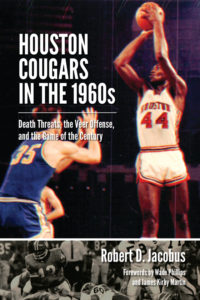
The University of Houston Libraries Special Collections is proud to announce its acquisition of the Ben DeSoto Papers. Ben DeSoto is a Houston native with a photography career spanning over three decades, and his collection documents Houston’s art, history, and culture.
The Ben DeSoto Papers document the Houston art scene and capture the images of hundreds of Houston’s visual artists. DeSoto’s collection also contains photos of hundreds of musicians and performances at many now-defunct Houston venues, including Mary Jane’s, The Axiom, and The Island. The latter venue is the subject of DeSoto’s documentary Night at the Island, which is currently in production. DeSoto describes The Island as
. . . the first venue in Houston where Punk Rock music was heard . . . From 1978 to 1982, the place was a home away from home for many and part of underground scene. Butthole Surfers, Black Flag, Big Boys, The Dicks shared the stage with locals Mydolls, Judys, AK 47, The Hates, and many others.
DeSoto’s collection contains images from these and many other musicians along with photographs of the Houston street skaters Urban Animals, many of which were exhibited at the Glassel and the Houston Center for Photography in the late 1980’s, and the Menil in 1998. Additionally, the collection contains personal and family documents.
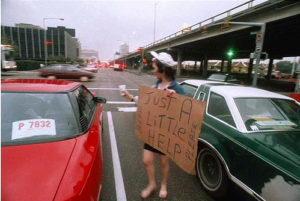
Judy Pruitt at 18 years old, under the Pierce Elevated, Christmas week 1988. Photo courtesy of Ben Desoto.
Perhaps most importantly, the Ben DeSoto Papers document DeSoto’s life’s work the Understanding Poverty Project in which he allows us into the daily lives of Houston’s homeless and poor. DeSoto explains that a chance encounter with Judy Pruitt in 1988 led to a decades-long collaboration in “sharing to the public an understanding of underlying causes of chronic homelessness.” Desoto also documented Ben White’s life for over thirty years. Like Pruitt, White battled the cycles of homelessness, drug addiction, and poverty. What is unique to this project is that DeSoto documents the experiences and struggles of Pruitt, White, and their families—over such an extended period of time. Currently, DeSoto is working on Quiet Storms of Reform–what he calls a “poverty solutions documentary film.”
DeSoto received numerous awards during his long career at the Houston Post, including the
- Fuji Fine Arts Award for Contributions to Society (1987)
- National Headliners, Outstanding Feature Photography (1989)
- Inter American Press Association, First in Photography (1990)
- Texas Correction Association Award for Media Excellence for “Documenting the Lives of Children and Families at Risk” (1991)
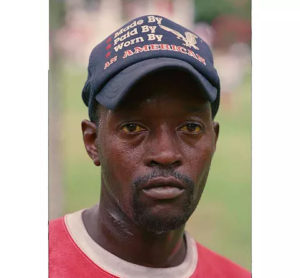
Ben White was born April 27, 1957, and grew up in Houston’s Fourth Ward (Freedman’s Town), Fifth Ward, and Sunny Side, all working-poor black neighborhoods. Photo courtesy of Ben Desoto.
In 2000 Desoto was awarded for his work with the Coalition for the Homeless of Houston/Harris County, Inc.
However, it is the recognition he has received for his more creative work, after his newspaper career, that he most values. A selection of his later awards follows:
- Houston Press, Best Art Exhibit and Best Photographer in Houston award from the for his exhibition His Understanding Poverty at City Hall (2009)
- Houston Arts Alliance grant for The Significance of Making Art
- “100 Creative People in Houston,” Houston Press (2011)
- UNESCO Bioethics Global Arts Competition for his project My Mother’s Dying, which to date has exhibited in Hong Kong, Houston, New York City, Mexico City, and Rome (2013)
- Top Ten Photographers listings: Houston Press, Free Press Houston, Green Mountain Express (2014)
In 2009, the office of Mayor Bill White commissioned City Workers of a Working City, Houston, Texas, which was installed on the third floor of City Hall. The Significance of Making Art was included in the 2009 No Zoning Show at the Contemporary Arts Museum, Houston and at the Artery (2010).
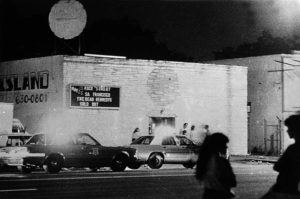
During his internship at the Houston Post the summer of 1980, Desoto particularly enjoyed his assignment taking photographs at The Island, Houston’s first punk rock venue. Photo courtesy of Ben Desoto.
DeSoto’s collection at UH Special Collections totals approximately 44 linear feet, and most materials date from the 1980s through 2016. Five linear feet of the collection came to UH Special Collections organized by Patricia Hernandez of Studio One through the CALL project. Included in this portion are photographs and negatives documenting Houston artists and art events as well as photographs of bands and musicians, primarily at Houston venues. While most of Desoto’s later work has been donated to UH Special Collections, his journalistic work for the Houston Post, as well as a majority of hip hop and materials related to Houston’s Fifth Ward neighborhood, have been donated to the African American Library at the Gregory School.
The collection is currently being processed and a finding aid is not yet available publicly. However, arrangements to use materials in the collection can be made by contacting Performing and Visual Arts curator Mary Manning at mmmanning@uh.edu.
College basketball used to be a small game. A niche sport, once it was played on small courts, in small gymnasiums, in front of small crowds. Just over fifty years ago however, on January 20, 1968 in the Astrodome, the University of Houston (and the University of California, Los Angeles) forever altered the scale of the game in what has become known as the Game of the Century.
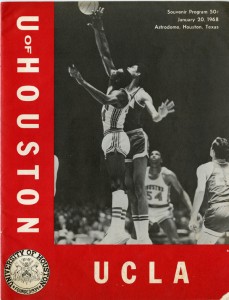
program from the Game of the Century (Athletics Department Records)
Regardless of the particulars, it was destined to be a historic match-up. While any given season might feature similar, high-profile, games between highly ranked teams, the 1968 regular season game between UCLA and Houston had a number of compelling story lines that intrigued even the casual sports fan. There was the blue blood, #1 team in the nation (the UCLA Bruins), riding a 47 game winning streak that spanned two and a half years and boasting three of the last four national championships under the tutelage of the legendary “Wizard of Westwood,” John Wooden. Their most recent in 1967 included a 73-58 defeat of the University of Houston Cougars in the Final Four. Anchored by the immeasurable talent of Lew Alcindor (later known as Kareem Abdul-Jabbar), the UCLA Bruins were a legitimate dynasty, ultimately claiming every national championship between 1967 and 1973. In the other corner, the up-and-coming “underdog” program, ranked #2 in the nation and riding their own winning streak (undefeated since their loss to UCLA the previous season), the University of Houston Cougars were coached by Guy V. Lewis, led on the court by the likes of Elvin Hayes, Ken Spain, and Don Chaney, and eager to prove just how good they were after last year’s setback.
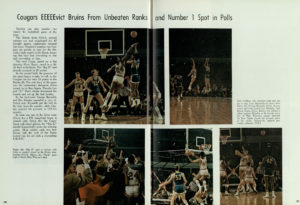
a full-color, two page spread from the 1968 Houstonian yearbook documents the Cougars’ victory
Given all of these particulars, how could the game be any bigger? Mix in a grand stage of national television coverage (a first for college basketball) and the surreal setting of the Eighth Wonder of the World.
The court for the contest was shipped in from Los Angeles, ironically enough, and assembled in the Astrodome on top of what should have been second base. It must have looked like a postage stamp to most of the 52,693 fans (a world-wide attendance record for any basketball game) packed into the dark corners of the Dome. Even more watched at home as this “small” game was played against a grand, cavernous backdrop.
TVS Television Network promoted the game and sold broadcasting rights to over 100 television stations across the country. Previously, there had only been efforts to televise games locally and in 1961 a “national” broadcast of the Ohio State / University of Cincinnati game in the NCAA finals was televised in just two cities–Columbus and Cincinnati, Ohio. The pros in the National Basketball Association had only begun the broadcast experiment in the 1950s and were still torn on whether or not they wanted to televise the league’s “good games,” for fear of losing ticket revenue at the turnstile. What was happening now in 1968 was not just novel, it was radical. And, it was successful in more ways than one. Houston defeated UCLA 71-69, ended the Bruins winning streak, and solidified their place in college basketball lore.
In Houston Cougars in the 1960s: Death Threats, the Veer Offense, and the Game of the Century by Robert Jacobus, Houston’s Elvin Hayes reflected back on the legacy of the game saying, “It just created euphoria and an atmosphere for college basketball that wasn’t there previously. I think that game kicked the door down, opened the windows, and knocked the roof off the house. What we have today in March Madness is what I think the game in 1968 opened.”
